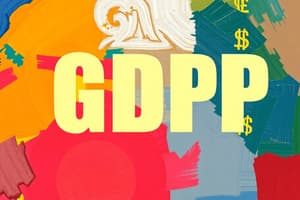Podcast
Questions and Answers
How does increased productivity typically influence the economy?
How does increased productivity typically influence the economy?
- Increased average wages and potential for higher living standards. (correct)
- Falling exports because domestic goods become more expensive.
- Decreased overall demand for goods and services.
- Higher unemployment rates due to automation.
Which scenario best describes the composition of the labor force?
Which scenario best describes the composition of the labor force?
- Employed individuals and unemployed people who are actively seeking work. (correct)
- Excluding contract workers and including only permanent employees.
- All adults who are not institutionalized.
- Including only those employed full-time and excluding part-time workers.
What broader economic condition is most likely indicated by a rising unemployment rate?
What broader economic condition is most likely indicated by a rising unemployment rate?
- Increase in overall productivity and output.
- Widespread wage increases across all sectors.
- Decline in the prices of consumer goods and services.
- Fewer available jobs and a potential economic slowdown. (correct)
Following an economic trough, which phase of the business cycle is next?
Following an economic trough, which phase of the business cycle is next?
What types of unemployment are accounted for in the natural rate of unemployment?
What types of unemployment are accounted for in the natural rate of unemployment?
What does it mean for an economy when its GDP is significantly below its potential output?
What does it mean for an economy when its GDP is significantly below its potential output?
What conditions typically define a state of full employment in an economy?
What conditions typically define a state of full employment in an economy?
What is the term for when a country's GDP decreases for two consecutive quarters?
What is the term for when a country's GDP decreases for two consecutive quarters?
Which indicator is most reliable for assessing the actual growth of an economy?
Which indicator is most reliable for assessing the actual growth of an economy?
What is a key reason why inflation is considered a significant economic problem?
What is a key reason why inflation is considered a significant economic problem?
Which of the following transactions is included when calculating GDP?
Which of the following transactions is included when calculating GDP?
According to the expenditure approach, which component of GDP is calculated as the residual after accounting for consumption, investment, and government purchases?
According to the expenditure approach, which component of GDP is calculated as the residual after accounting for consumption, investment, and government purchases?
A family decides to purchase a newly built house. In which component of GDP would this transaction be included?
A family decides to purchase a newly built house. In which component of GDP would this transaction be included?
How would a significant decrease in business inventories likely impact GDP, assuming other factors remain constant?
How would a significant decrease in business inventories likely impact GDP, assuming other factors remain constant?
How does adjusting nominal GDP to derive real GDP affect our understanding of economic growth?
How does adjusting nominal GDP to derive real GDP affect our understanding of economic growth?
Which of the following scenarios highlights a significant limitation of using GDP as the sole measure of a nation's well-being?
Which of the following scenarios highlights a significant limitation of using GDP as the sole measure of a nation's well-being?
If nominal GDP increases by 8% and the price level, as measured by a broad price index, increases by 3%, what is the approximate percentage change in real GDP?
If nominal GDP increases by 8% and the price level, as measured by a broad price index, increases by 3%, what is the approximate percentage change in real GDP?
How does Gross National Product (GNP) differ from Gross Domestic Product (GDP) in measuring a country's economic output?
How does Gross National Product (GNP) differ from Gross Domestic Product (GDP) in measuring a country's economic output?
Which of the following scenarios would most likely lead to a decrease in a country's GDP, assuming all other factors remain constant?
Which of the following scenarios would most likely lead to a decrease in a country's GDP, assuming all other factors remain constant?
A country's exports are $500 billion and its imports are $600 billion. Based on this information, what is the value of net exports, and how does it impact GDP?
A country's exports are $500 billion and its imports are $600 billion. Based on this information, what is the value of net exports, and how does it impact GDP?
Flashcards
GDP Definition
GDP Definition
The total market value of final goods and services produced within a country in a specific time period.
Final Goods and Services
Final Goods and Services
Goods and services purchased by the final user; included in GDP.
Consumption (in GDP)
Consumption (in GDP)
Spending by households on goods and services.
Investment (in GDP)
Investment (in GDP)
Signup and view all the flashcards
Real GDP
Real GDP
Signup and view all the flashcards
Nominal GDP
Nominal GDP
Signup and view all the flashcards
Gross National Product (GNP)
Gross National Product (GNP)
Signup and view all the flashcards
Net Exports
Net Exports
Signup and view all the flashcards
Government Spending (in GDP)
Government Spending (in GDP)
Signup and view all the flashcards
Intermediate Goods
Intermediate Goods
Signup and view all the flashcards
Inflation
Inflation
Signup and view all the flashcards
Deflation
Deflation
Signup and view all the flashcards
GDP deflator
GDP deflator
Signup and view all the flashcards
Real Wages
Real Wages
Signup and view all the flashcards
Cost-of-living Adjustment (COLA)
Cost-of-living Adjustment (COLA)
Signup and view all the flashcards
Consumer Price Index (CPI)
Consumer Price Index (CPI)
Signup and view all the flashcards
Borrower
Borrower
Signup and view all the flashcards
Base Year for CPI
Base Year for CPI
Signup and view all the flashcards
Higher Production Costs
Higher Production Costs
Signup and view all the flashcards
Expansion
Expansion
Signup and view all the flashcards
Study Notes
Measuring Economic Activity and GDP
- GDP includes final goods and services
- GDP does not include intermediate goods, household production or illegal transactions
- Savings is not part of the expenditure approach to GDP
- Consumption in GDP is exemplified by purchasing groceries
- An increase in business investment is likely to increase GDP
- Real GDP adjusts for changes in prices
- Measuring only tangible goods is not a limitation of GDP as a measure of well-being
- With nominal GDP growth at 5% and inflation at 3%, real GDP growth is approximately 2%
- Gross National Product (GNP) measures output produced by citizens of a country, irrespective of location
- A decrease in government spending would cause GDP to decrease
- Net exports in GDP refer to exports minus imports
- Buying company shares is not considered investment in GDP
- Increased productivity would increase GDP
Bird’s Eye View of the Economy
- Economic growth typically results in higher living standards
- The labor force includes employed and unemployed people actively seeking work
- A rise in the unemployment rate usually means fewer people are working
- Expansion is the phase of the business cycle that follows a trough
- The natural rate of unemployment includes frictional and structural unemployment
- When GDP is below potential output, the economy is underperforming
- Only frictional and structural unemployment exist in a situation that indicates full employment
- If GDP growth is negative for two quarters, this is called a recession
- Real GDP growth is an indicator of economic performance
Measuring Price Level and Inflation
- Inflation is a concern because it reduces the value of money
- Deflation can lead to lower consumer spending
- The GDP deflator measures overall price changes in the economy
- Real wages fall when inflation is higher than wage growth
- A cost-of-living adjustment (COLA) is designed to increase wages with inflation
- If the CPI is rising quickly, it suggests inflation
- Borrowers benefit from unexpected inflation
- The base year for CPI is the year when prices are compared for future years
- Inflation can result from higher production costs
Studying That Suits You
Use AI to generate personalized quizzes and flashcards to suit your learning preferences.



